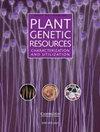谷子(Eleusine coracana L. Gaertn.)耐旱产量贡献性状及基因型鉴定
IF 0.7
4区 生物学
Q3 PLANT SCIENCES
Plant Genetic Resources: Characterization and Utilization
Pub Date : 2023-03-01
DOI:10.1017/s1479262123000011
引用次数: 0
摘要
为获得作物改良所需的耐旱供体,对特定性状的种质筛选是一个持续的前育种过程。本研究利用干旱胁迫28 d对17个中晚育五谷基因型进行了评价,利用不同的统计分析方法确定了五谷的耐旱性状和基因型。叶片光合速率(降低26.3%)、气孔导度(降低26.4%)、蒸腾速率(降低24.8%)和籽粒产量(降低13.2%)对DS敏感,但叶片温度升高4.7%。通径分析和多元线性回归分析表明,丰水条件下,平均穗重和有效分蘖对籽粒产量的贡献显著。而在DS条件下,平均穗重、有效分蘖数和脱粒率对籽粒产量的贡献相同。根据对籽粒产量有显著影响的性状排序,平均穗重(10.65 g)较高的基因型GE-4683优于常用品种GPU-28。多元线性回归方程预测了将GPU-28在DS下的产量从现有的每平方米360.0克提高到每平方米459.5克(提高29.1%)的可能性,方法是在MLR方程中采用三个生产性分蘖,而不是现有的每株两个分蘖。平均穗重每增加1.0克,籽粒产量将从360.0克增加到392.0克,相当于3.60吨/公顷增加到3.92吨/公顷(提高9.4%)。本文章由计算机程序翻译,如有差异,请以英文原文为准。
Identification of yield contributing traits and genotypes to drought tolerance in finger millet (Eleusine coracana L. Gaertn.)
Screening of germplasm for specific traits is a continuous pre-breeding process in deriving the drought-tolerant donors required for crop improvement. The study evaluated 17 medium-late duration finger millet genotypes under drought stress (DS) for 28 days during the reproductive stage to identify the traits and genotypes for drought tolerance using different statistical analysis. The photosynthetic rate (by 26.3%), stomatal conductance (by 26.4%), transpiration rate (by 24.8%) and grain yield (by 13.2%) were decreased and found sensitive to DS, but the leaf temperature was increased (4.7%). From the path analysis and multiple linear regression analysis, the mean ear weight and productive tillers were found to contribute to the grain yield significantly under well-watered conditions. While under DS conditions, the mean ear weight, productive tillers and threshing percentage equally contributed to grain yield. Based on the ranking of traits significantly contributing to grain yield, the genotype GE-4683 with a higher mean ear weight (10.65 g) was found superior to the popular variety, GPU-28. The Multiple linear regression equation predicts the possibility to increase the yield of GPU-28 under DS from the existing 360.0 to 459.5 g per square metre (by 29.1%) by the incorporation of three productive tillers instead of the existing two tillers per plant in the MLR equation. An additional 1.0 g of mean ear weight will be able to predict an increased grain yield from 360.0 to 392.0 gm−2, equivalent to 3.60 to 3.92 t/ha (by 9.4%).
求助全文
通过发布文献求助,成功后即可免费获取论文全文。
去求助
来源期刊

Plant Genetic Resources: Characterization and Utilization
Agricultural and Biological Sciences-Agronomy and Crop Science
CiteScore
2.80
自引率
0.00%
发文量
29
审稿时长
>12 weeks
期刊介绍:
Plant Genetic Resources is an international journal which provides a forum for describing the application of novel genomic technologies, as well as their integration with established techniques, towards the understanding of the genetic variation captured in both in situ and ex situ collections of crop and non-crop plants; and for the airing of wider issues relevant to plant germplasm conservation and utilisation. We particularly welcome multi-disciplinary approaches that incorporate both a technical and a socio-economic focus. Technical aspects can cover developments in technologies of potential or demonstrated relevance to the analysis of variation and diversity at the phenotypic and genotypic levels.
 求助内容:
求助内容: 应助结果提醒方式:
应助结果提醒方式:


